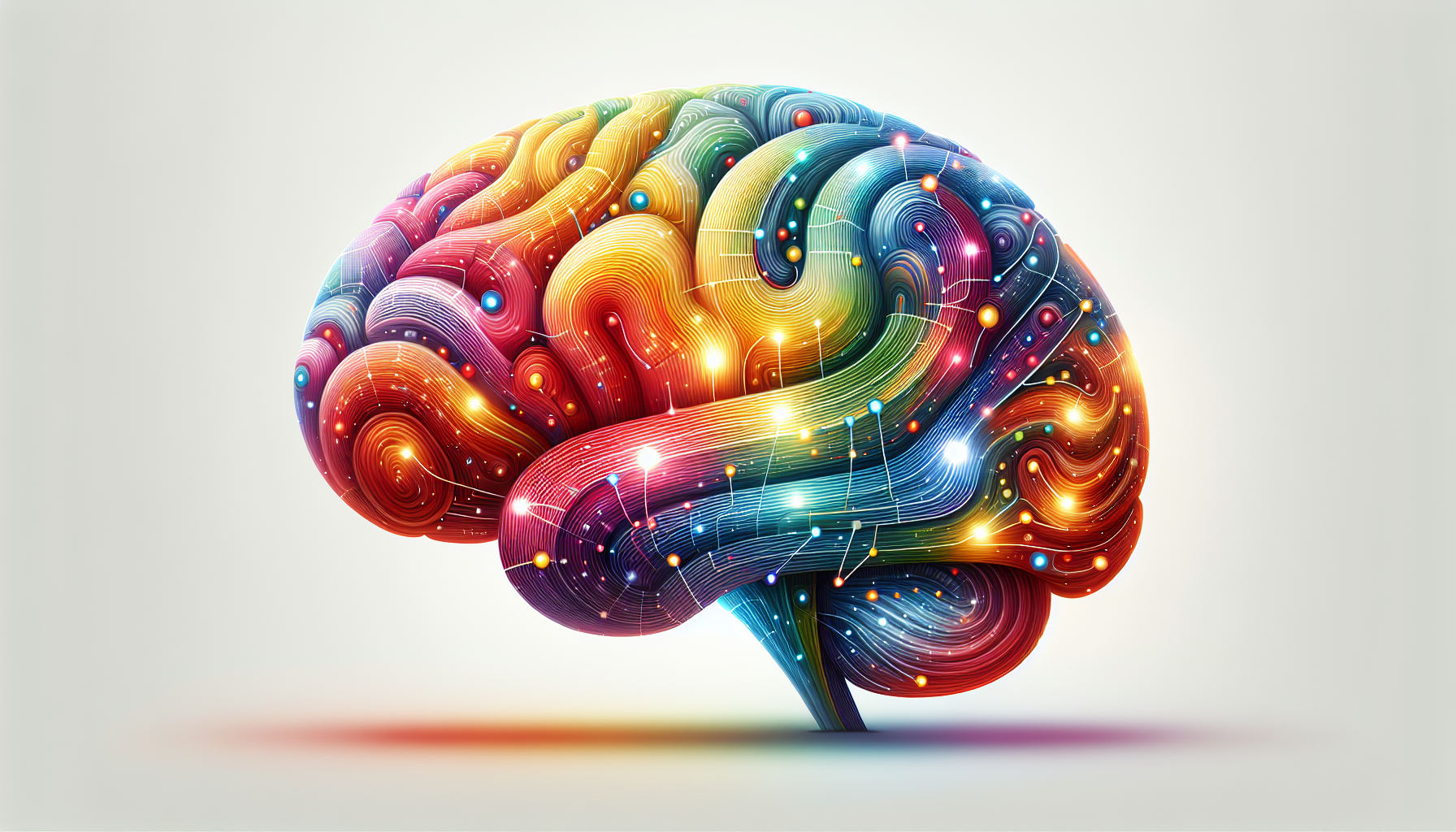On this page

The book "Livewired: The Inside Story of the Ever-Changing Brain" presents a comprehensive understanding of the brain's dynamic and adaptable nature, known as 'Livewired'. It discusses the brain's ability to reconfigure itself, adapt to changes, and mold its resources to match circumstances. The content provides several examples of the brain's adaptability, such as a child who regained developmental progress after having half of his brain removed, and how our experiences shape who we are. The concepts of 'plasticity' and 'Livewired' are introduced, highlighting the brain's ability to change, hold that change, and adapt to an information-seeking nature. The importance of life experiences in individual development, the impact of early life social interactions, and the brain's dependency on experiences are also discussed. The book further explores the brain's ability to form new connections if parts of the body are lost, the phenomenon of phantom limbs, and the principle of 'neurons that fire together wire together'. Lastly, it discusses the brain's ability to map the body, regardless of its shape, onto its surface, demonstrating its remarkable capacity to represent and control the body, and its adaptability to different physical forms.
How does it apply to you?
Understanding the brain's adaptability could lead to advancements in neurorehabilitation, education, and mental health treatments. It also highlights the importance of providing enriching environments and experiences for optimal brain development.
Applied Learning
The concept of Livewired, which refers to the brain's ability to reconfigure itself as needed, is akin to the principle of adaptability in software development. Developers should strive to build software that can adapt to changing user requirements, technological advances, and market conditions. In this context, Livewired can be seen as a metaphor for agile development practices, which prioritize flexibility and iterative improvement.
Constantly Learning
The dynamic nature of the brain, as exemplified by the young boy who was able to relearn language after surgery, mirrors the continuous learning process in a software development organization. Developers must constantly learn new technologies and techniques to stay relevant and effective. Likewise, a software development organization must foster a culture of continuous learning and improvement.
Time-sensitive
The dependency of the brain on experiences to unpack its programming within a rapidly closing window of time is similar to the time-sensitive nature of software development. Delays in detecting and fixing bugs, or in releasing new features, can result in significant costs. Therefore, software development organizations must prioritize timely action and decision-making.
New Connections
The brain's ability to form new connections if parts of the body are lost, and the phenomenon of phantom limbs, can be likened to the process of refactoring in software development. When parts of a codebase are removed or changed, developers must ensure that the rest of the codebase adapts to these changes without breaking. This requires careful planning and testing.
Brain Territory
The principle that 'neurons that fire together wire together' and the concept of brain 'territory' can be applied to the collaborative nature of software development. Developers who work together on a project form stronger connections and produce better results. Likewise, maintaining a well-organized codebase, where each component has a clear role and function, is crucial for efficient software development.
Resiliency
The brain's ability to redeploy inactive or damaged areas to enhance other senses or skills, and its remarkable flexibility and resilience, can inspire software development practices. Developers should strive to build resilient software that can handle failures gracefully, and that can quickly adapt to new requirements or conditions.
Modularity
The brain's ability to process information from different sources and dynamically wire itself to represent and act upon the incoming data can be seen as a metaphor for the principle of modularity in software development. Developers should strive to build software that can handle different types of data and that can be easily extended or modified to meet new requirements.
Developer Checklist
Understanding the Brain
Brain's Adaptability
Brain's Wiring and Rewiring
Brain's Mapping and Decoding
Applying Brain's Principles to Software Development
Brain's Learning and Memory Formation
Key Points
The Electric Living Fabric - Introduces the concept of Livewired, the brain's ability to reconfigure itself as needed. The human brain adapts to its environment using basic building blocks.
The Child with Half a Brain - Discusses a young boy who regained his developmental progress after half of his brain was removed. This highlights the brain's ability to adapt to changes.
Life’s Other Secret - Explores how our experiences shape who we are, not just our genetics. The human brain can change based on new experiences and skills..
If You’re Missing the Tool, Create It - Shows how the brain molds its resources to match its circumstances. An expert's brain develops specific neural circuitry for their expertise.
An Ever-Changing System - Introduces the terms 'plasticity' and 'Livewired', which describe the brain's ability to change, adapt, and seek information.
How to Grow a Good Brain - Brains are not blank slates at birth but have pre-existing expectations. Infants have innate abilities like language absorption and mimicking adults.
Experience Necessary - Life experiences, not just innate intelligence, play a crucial role in development. The environment and experience impact brain development.
Nature’s Great Gamble - Early life social interactions heavily influence human development. Missing crucial developmental windows can lead to long-term skill acquisition difficulties.
The Case of the Silver Spring Monkeys - The brain can form new connections if body parts are lost. Specific brain areas control different body aspects, demonstrating the brain's adaptability.
The Afterlife of Lord Horatio Nelson’s Right Arm - Discusses phantom limbs, a phenomenon where the brain reconfigures itself after a limb loss, resulting in the sensation of still feeling the lost limb.
Timing Is Everything - Emphasizes the principle that 'neurons that fire together wire together.' Simultaneously used brain parts form stronger connections, fundamental to learning and memory formation.
Colonization Is a Full-Time Business - If brain parts stop receiving or sending information, they lose their function. This showcases the brain's plasticity and constant adaptation.
The More the Better - The brain can redeploy inactive or damaged areas to enhance other senses or skills/ The age at which a sense is lost can affect the extent of this cortical takeover.
Blindingly Fast - The brain can rewire itself rapidly in response to changes in sensory input, but reverts back to its original configuration once normal conditions are restored/
What Does Dreaming Have to Do with the Rotation of the Planet? - Dreams maintain the activity of the visual cortex during sleep, preventing it from being taken over by other functions.
As Outside, So Inside - The brain can map the body onto its surface, regardless of its shape/ This demonstrates the brain's capacity to represent and control the body, and its adaptability to different physical forms.
Dynamic Wiring of the Brain - The brain processes information from sensory organs, regardless of the data source. It can retrain itself to interpret data from different sources, dynamically wiring itself to best represent and act upon the incoming data.
The Planet-Winning Technology of the Potato Head - Sensory organs convert information from the outside world into electrical signals that the brain can interpret. Evolution can introduce new sensors, which the brain will learn to utilize.
Sensory Substitution - The brain can interpret data from alternative channels, such as camera data fed into the skin. The brain can learn from any source of sensory input, regardless of how the signals are received.
The One-Trick Pony - The cortex is pluripotent and can develop differently depending on the inputs. The brain dynamically wires itself to best represent the incoming data.
Eye Tunes - Rigorous training is necessary for the brain to understand signals from sensory substitution technologies. The brain can extract shape information from any incoming signals.
Good Vibrations - The brain can decode complex patterns to understand language Sensory substitution can compensate for sensory loss, as shown by methods developed for deafblind individuals and for people with prosthetic limbs.
Enhancing the Peripherals - Sensory enhancements can occur naturally or through engineering Examples include color vision in genetically engineered mice, and a helmet that allows 360-degree vision.
Conjuring a New Sensorium - There is potential for sensory expansion, such as a person being able to detect electromagnetic fields, or surgeons receiving real-time patient data.
Imagining a New Color - The structure of data determines the subjective experience of a sense. If new senses are developed, it may not be possible to explain the new sense to others.
Are You Ready for a New Sensation? - The potential future of sensory technology includes the possibility of a two-tiered society and the potential for a speciation event.
Adaptation to Body Changes - The brain can adapt to changes in the body, such as the loss of a limb, by reorganizing to match the new body plan
Variations in Body Plans - Small genetic alterations can result in a wide array of body variations, highlighting the diversity and adaptability of the human body.
Motor Babbling and Learning Movement - Motor babbling is a method of learning movement that has been adopted in robotics. Brains can incorporate tools as natural extensions to be controlled.
Sensory Feedback in Robotic Arms and Avatar Robotics -
- Lack of sensory feedback in controlling robotic arms can be overcome by feeding patterns of activity into the somatosensory cortex.
- This concept is extended in avatar robotics and virtual reality, allowing for control at a distance and instant, inexpensive body plan changes.
Self-Control and Asomatognosia
- Asomatognosia, a condition causing a person to lose control of a limb, emphasizes the brain's complex role in self-control and perception.
- A sense of predictability may be related to deep familiarity with a person.
Livewiring and Infinite Body Plans
- Livewiring leads to infinite body plans, showcasing the brain's capacity for adaptation and change, and allowing for a wide array of body plan possibilities
Why Mattering Matters
- Motivation, engagement, and curiosity are key in learning and skill acquisition, as exemplified by the Polgár sisters' training in chess.
- Their performance was rewarded with approval and attention, shaping their brain circuitry to be highly adept at chess.
The Motor Cortices of Perlman Versus Ashkenazy
- The brain adapts to activities that one repeatedly engages in, as seen in musicians who have trained for thousands of hours.
- Mastery in any field requires at least 10,000 hours of practice.
Fashioning the Landscape
- Our experiences shape our neural landscape.
- The frequent occurrence of phantom cell phone vibrations and the auditory system's wiring to maximize language distinctions are examples of this.
Dogged
- Desire is crucial in achieving expertise.
- Constraint therapy, which retrains the damaged cortex by forcing the use of the impaired limb, illustrates how brains adapt to challenges by reallocating resources and restructuring organizations.
Allowing the Real Estate to Change
- The brain has adaptive capabilities, with emergency mechanisms ensuring retention of critical events.
- Neural changes require specific neurotransmitters correlating with investment, curiosity, and interest.
- Adaptive software keeps students at their point of struggle, making learning challenging yet achievable.
The Brain of a Digital Native
- The internet's impact on learning is significant, with immediate availability of information resulting in more effective learning.
- The gamification of education can enhance learning experiences.
- The accessibility of knowledge through digital devices is a significant development in education.
A Horse in the River
- The brain is always adjusting to its environment, creating a 'ground truth' as a basis for detecting changes.
- This continuous downward motion leading to active recalibration is a common occurrence in everyday life.
Making Invisible the Expected
- The Troxler effect shows how a constant stimulus in our peripheral vision eventually disappears.
- Successful adaptation makes regularities invisible and attention allows for high-resolution sensing.
The Difference Between What You Thought Would Happen and What Actually Happened
- The brain adjusts to make guesses about the world, reconfiguring its network to conserve power.
- Differences between predictions and outcomes are critical to understanding learning.
- The concept of 'blocking' occurs when there is a discrepancy between expectation and reality.
Going Toward the Light. Or Sugar. Or Data.
- The concept of infotropism suggests that neural circuitry constantly adjusts to maximize the amount of information it can extract from the environment.
- The 'infotropism hypothesis' proposes that brains adjust to maximize the data that matters.
Adjusting to Expect the Unexpected -
- The brain's predictive nature reshapes itself to have good expectations and be maximally sensitive to the unexpected.
- Professionals burn predictions of the world directly into their circuitry, while amateurs scramble to make a reasonable forecast.
Balancing on the Edge of Change - Discusses the stability of the brain as a result of balanced counterforces Different forces within the brain act against each other, maintaining overall stability
When Territory Disappears - Explores the brain's adaptability, such as adjustments in the visual field due to one hemisphere developing more than the other Highlights the flexibility of brain maps in adapting to changes
How to Spread Drug Dealers Evenly - Talks about competition among neurons for resources and their dependence on neurotrophins Discusses the importance of a well-balanced system for optimal functioning and the domination effect in neurons
How Neurons Expand Their Social Network - Describes the initial state of the brain as heavily interconnected, pruning over time Discusses the brain's silent connections that can be activated in response to change and potential long-term changes
The Benefits of a Good Death - Explains apoptosis, the process of programmed cell death crucial for shaping a nervous system Uses the transformation from a webbed hand to defined fingers as an analogy, emphasizing that development depends on eliminating cells
Is Cancer an Expression of Plasticity Gone Awry? - Explores the idea that tumors are an expression of misdirected plasticity Details how mutations can give a slight advantage to a cell, leading to more mutations and competition, which can turn disastrous
Saving the Brain Forest - Discusses the reliance of neurons on neurotrophic factors and the importance of understanding the competitive strategies neurons use for preserving and enhancing brain health
Challenges of Learning in Older Brains - Examines the difficulty older brains face in reassigning established regions for new tasks due to less flexibility compared to younger brains Discusses how changes in older brains occur in isolated areas
Importance of the Sensitive Period in Learning - Highlights the sensitive period when brains are most adaptable Discusses the implications if learning doesn't take place during this period, with an example of language acquisition
Variability in Brain Plasticity - Explores the variability in the brain's sensitive periods and plasticity across different tasks and regions Discusses how plasticity reduces with age but not uniformly across the brain
Maintaining Brain Function and Change with Age - Discusses how active mental activities can preserve brain function despite age-related neurodegeneration Talks about the change in brains when confronted with unpredictable situations and the impact of new experiences on plasticity
Remember When - Addresses the stability of older memories compared to newer ones, known as Ribot’s Law Notes the occurrence of individuals reverting to their childhood language towards the end of their lives
Talking to Your Future Self - Discusses the nature of memory storage, demonstrating that memory is not localized to a single spot but distributed broadly, similar to the structure of cloud computing
FAQs
What is the concept of Livewired? Livewired refers to the brain's ability to reconfigure itself as needed. The human brain is not entirely prescripted but is set up with basic building blocks that allow it to adapt to its environment.
Can a person function with half a brain? Yes, using the example of a young boy who had half of his brain removed. Despite this, he was able to relearn language and almost completely regain his developmental progress through the brain's ability to rewire itself and adapt to changes.
What shapes who we are, experiences or genetics? Our experiences shape who we are, not just our genetics. The human brain is adaptable and can change based on new experiences and skills.
How does the brain adapt to circumstances? The brain molds its resources to match its circumstances. It develops specific neural circuitry for their expertise, such as a soccer player's brain developing neural circuitry specific to soccer.
What is brain plasticity? Brain plasticity, coined by American psychologist William James, describes the brain's ability to change and hold that change.
What affects individual development apart from innate intelligence? Life experiences play a crucial role in individual development. For instance, studies have shown that rats raised in enriched environments perform better at tasks and have healthier neurons compared to those from deprived environments.
What is the impact of early life social interactions on human development? Human development relies heavily on early life social interactions. Normal visual circuit development, for example, is dependent on normal visual inputs. Missing this crucial developmental window can lead to long-term difficulties in acquiring certain skills or abilities.
What happens to the brain when a limb is lost? After losing a limb, the brain reconfigures itself and takes over the part that previously controlled the lost limb. This results in the sensation of still feeling the lost limb, known as a phantom limb.
What is the principle 'neurons that fire together wire together'? This principle means that when certain parts of the brain are used simultaneously, they form stronger connections and take up more 'real estate' in the brain. This process is fundamental to learning and memory formation.
What happens if certain parts of the brain stop receiving or sending information? If certain parts of the brain stop receiving or sending information, they lose their 'territory' or function. This is another demonstration of the brain's plasticity and its constant adaptation to changing circumstances.
What role do dreams play in brain function? Dreams maintain the activity of the visual cortex during sleep, when there is no visual stimulation. By dreaming, the brain keeps this part of the brain active and prevents it from being taken over by other functions.
Can the brain map the body regardless of its shape? Yes, the brain can map the body, regardless of its shape, onto its surface. This illustrates the brain's remarkable capacity to represent and control the body, and its adaptability to different physical forms.
Can the brain process information from different sensory organs? Yes, the brain processes information from sensory organs, regardless of the source of the data. It can retrain itself to interpret data from different sources, such as a video camera, as touch on the skin.
What are sensory organs? Sensory organs are peripheral devices that convert information from the outside world into electrical signals that the brain can interpret.
What is sensory substitution? Sensory substitution is the process by which the brain can learn to interpret data from the wrong channels, such as feeding data from a camera into the skin.
What is the significance of the brain's dynamic wiring? The brain's dynamic wiring allows it to best represent and act upon the incoming data, adapting to different inputs.
What is the Tadoma method? The Tadoma method was developed to teach deafblind children to understand language by feeling the lips, vocal cords, and air coming out of the nostrils.
What are some examples of superpowered sensory brains? Examples include mice genetically engineered to have color vision and human females with four kinds of color photoreceptors.
What is the concept of shared perception? Shared perception is a concept where a person can feel another person's data, such as real-time weather data or the sentiment of a room.
What is the potential impact of new senses? New senses could potentially reduce the resolution of other senses or carry emotional weight.
What is motor babbling? Motor babbling is a method of learning movement seen in babies and cyclists, which has been adopted in robotics to create systems that can figure themselves out.
What is sensory feedback in robotic arms and avatar robotics? Sensory feedback in robotic arms involves redirecting outgoing brain signals to control the robotic arm. This idea is used in avatar robotics, which allows a person to control a robot at a distance. In virtual reality, this concept permits massive changes to the body plan to be made instantly and inexpensively.
What is asomatognosia? Asomatognosia is a condition resulting from damage to the right parietal lobe of the brain, causing a person to lose control of a limb and even deny ownership of the limb. It highlights the brain's complex role in self-control and perception.
What is livewiring and how does it relate to body plans? Livewiring is the brain's ability to adapt and change, which can lead to infinite body plans. It is like a car engine that adjusts itself to optimally drive any type of vehicle, emphasizing the brain's remarkable capacity for adaptation.
What is the ten-thousand-hour rule? The ten-thousand-hour rule is the idea that mastery in any field requires at least 10,000 hours of practice. This rule reflects how the brain adapts to activities that one repeatedly engages in.
How do our experiences shape our neural landscape? Our experiences shape our neural landscape by wiring our systems to maximize certain distinctions based on our environment. For example, the auditory system wires itself to maximize language distinctions based on one's environment from birth.
What is the concept of active recalibration? Active recalibration is the concept that the brain is always adjusting to its environment, creating a 'ground truth' as a basis for detecting changes.
What is the Troxler effect? The Troxler effect demonstrates how a constant stimulus in our peripheral vision eventually disappears. It is related to the visual systems of reptiles, which only register change.
What is the concept of 'blocking' in learning? 'Blocking' is a concept in learning that occurs when there is a discrepancy between expectation and reality. It explores how the brain adjusts to make guesses about the world, and reconfigures its network to conserve power.
What is the 'infotropism hypothesis'? The 'infotropism hypothesis' proposes that brains adjust to maximize the data that matters. It suggests that neural circuitry constantly adjusts to extract the maximum amount of information possible from the environment.
How does the brain reshape itself for predictions? The brain reshapes itself to have good expectations and be maximally sensitive to the unexpected. It models the state of the world to make accurate predictions and responds to discrepancies between predictions and outcomes.
What is the concept of balanced counterforces in the brain? This concept suggests that different forces within the brain are continually acting against each other in a way that maintains overall stability.
How does the brain adapt when one hemisphere develops more than the other? The entire visual field adjusts to be represented on the available hemisphere, highlighting the flexibility of brain maps in adapting their functions according to the changes.
What is the importance of a well-calibrated system in neurons? A well-calibrated system requires just the right balance of inhibition and excitation, leading to a Goldilocks zone where everything is 'just right'.
What is apoptosis and why is it crucial for sculpting a nervous system? Apoptosis is the process of programmed cell death and is crucial for sculpting a nervous system. This development depends on eliminating cells, not adding them.
How can tumors be seen as an expression of plasticity gone wrong? Tumors involve mutations that give a slight advantage to a cell, leading to further mutations and competition. In a system that's wound so tightly for competition, a tiny advantage can turn disastrous, leading to a ratcheting up of mutations.
What is the sensitive period in learning? The sensitive period refers to a phase when brains are most adaptable, and it varies depending on the task. If learning doesn't take place during this period, individuals may need to adjust tasks to fit their brain, rather than their brain adapting to tasks.
How can engaging in active mental activities help preserve brain function? Engaging in active mental activities can help preserve brain function despite age-related neurodegeneration. This phenomenon is evident in some nuns who exhibited Alzheimer's pathology but showed no cognitive symptoms.
What is Ribot’s Law? Ribot’s Law addresses the stability of older memories compared to newer ones.
What is the nature of memory storage? Memory storage is distributed broadly, likened to the structure of cloud computing or the way an email inbox is scattered across servers globally, often with high redundancy.
Glossary
Livewired: Refers to the brain's ability to reconfigure itself as needed. The human brain is not entirely prescripted but is set up with basic building blocks that allow it to adapt to its environment.
Dynamic Nature of the Brain: The ability of the brain to rewire itself and adapt to changes. This is demonstrated through the example of a young boy who had half of his brain removed and was still able to relearn language and almost completely regain his developmental progress.
Plasticity: Coined by American psychologist William James, it describes the brain's ability to change and hold that change.
Innate Abilities: Pre-existing abilities that humans are born with, such as language absorption and mimicking adults. These abilities highlight the brain's sophisticated capacity to translate visual input into motor actions.
Experience and Environment Impact: The crucial role life experiences and environment play in individual development. This is demonstrated through studies showing that enriched environments and education can lead to better performance and more elaborate neural networks.
Developmental Window: A crucial period in early life during which the brain is especially open to certain experiences and inputs. Missing this window can lead to long-term difficulties in acquiring certain skills or abilities.
Phantom Limb: A phenomenon that occurs after the loss of a limb, where the brain reconfigures itself and takes over the part that previously controlled the lost limb. This results in the sensation of still feeling the lost limb.
'Neurons that fire together wire together': A principle stating that when certain parts of the brain are used simultaneously, they form stronger connections and take up more 'real estate' in the brain. This process is fundamental to learning and memory formation.
Cortical Takeover: The process by which the brain can redeploy inactive or damaged areas to enhance other senses or skills. This is particularly evident in individuals who lose their sight, where the brain devotes more territory to the remaining, undamaged senses.
Brain Flexibility and Resilience: The brain's ability to rewire itself rapidly in response to changes in sensory input and revert back to its original configuration once normal conditions are restored.
Role of Dreams: Dreams maintain the activity of the visual cortex during sleep, when there is no visual stimulation. By dreaming, the brain keeps this part of the brain active and prevents it from being taken over by other functions.
Brain's Body Mapping: The brain's ability to map the body, regardless of its shape, onto its surface. This illustrates the brain's remarkable capacity to represent and control the body, and its adaptability to different physical forms.
Dynamic Wiring of the Brain: The brain's ability to process information from sensory organs, regardless of the source of the data. It can retrain itself to interpret data from different sources, such as a video camera, as touch on the skin.
Adaptation to Body Changes: The brain's remarkable ability to adapt to changes in the body, such as shrinking cortical territory for limbs that no longer exist, and reorganizing to match the new body plan.
Conjuring a New Sensorium: The process of developing new senses through various methods, such as implanting a magnet in the fingers to detect the electromagnetic bubble, or feeding real-time patient data into surgeons during operations.
Enhancing the Peripherals: The act of improving or augmenting sensory abilities, such as genetically engineering mice to have color vision, or using a helmet that lets users see in 360 degrees.
Eye Tunes: The process of training the brain to make sense of signals from sensory substitution technologies, such as the vOICe, a technology that can be downloaded for free on phones around the world.
Good Vibrations: The brain's ability to unconsciously decode complicated patterns to understand language, or decipher signals by correlating actions with consequences.
Imagining a New Color: The concept that the structure of data determines the subjective experience of a sense, and the potential impact of new senses.
Motor Babbling and Learning Movement: A method of learning movement seen in babies and cyclists, adopted in robotics to create systems that can figure themselves out.
Sensory Substitution: The brain's ability to interpret data from the wrong channels, such as feeding data from a camera into the skin, and learning to interpret the information, regardless of the route by which the signals entered.
The One-Trick Pony: The concept that any patch of the cortex is pluripotent and can develop into different fates, depending on the inputs.
The Planet-Winning Technology of the Potato Head: The concept that sensory organs are peripheral devices that convert information from the outside world into electrical signals that the brain can interpret.
Variations in Body Plans: The concept that there are no standard blueprints for body plans and small genetic alterations can result in a wide array of variations.
Are You Ready for a New Sensation?: Speculation on the future of sensory technology, considering the possibility of a two-tiered society and the potential for a speciation event.
Active Recalibration: The brain's constant adjustment to its environment in order to create a 'ground truth' as a basis for detecting changes.
Asomatognosia: A condition resulting from damage to the right parietal lobe of the brain, causing a person to lose control of a limb and even deny ownership of the limb.
Avatar Robotics: A technology that allows a user to control a robot at a distance, often used in virtual reality.
Blocking: A concept in which there is a discrepancy between expectation and reality, often used in the context of learning and adaptation.
Constraint Therapy: A therapy method that retrains damaged cortex by forcing use of the impaired limb, with rewards reinforcing effective methods.
Infotropism: The concept that neural circuitry constantly adjusts to maximize the amount of information it can extract from the environment.
Livewiring: A concept that emphasizes the brain's remarkable capacity for adaptation and change, allowing for a wide array of possibilities in body plans.
Motor Cortices: Areas of the brain involved in the planning, control, and execution of voluntary movements.
Sensory Feedback: The process of feeding patterns of activity into the somatosensory cortex to translate into a full perception of a limb being the person's own in robotic arms control.
Troxler Effect: A phenomenon of visual perception that demonstrates how a constant stimulus in our peripheral vision eventually disappears.
Balancing on the Edge of Change: The idea that different forces within the brain are continually acting against each other in a way that maintains overall stability.
When Territory Disappears: The adaptability of the brain, such as when one hemisphere develops more than the other, the entire visual field adjusting to be represented on the available hemisphere.
How to Spread Drug Dealers Evenly: The competition among neurons for resources and their reliance on neurotrophins, proteins secreted by the neurons' targets.
How Neurons Expand Their Social Network: The initial state of the brain, which starts off heavily interconnected and prunes the overlap with time, but some cross-wiring remains.
The Benefits of a Good Death: The concept of apoptosis, which is the process of programmed cell death and is crucial for sculpting a nervous system.
Is Cancer an Expression of Plasticity Gone Awry?: The idea that tumors can be seen as an expression of plasticity gone wrong.
Saving the Brain Forest: How neurons rely on neurotrophic factors, which are like sunlight for trees in a forest.
Challenges of Learning in Older Brains: Older brains find it difficult to reassign established regions for new tasks, unlike younger brains which are more flexible in reimagining their neural maps.
Importance of the Sensitive Period in Learning: The sensitive period refers to a phase when brains are most adaptable, and it varies depending on the task.
Variability in Brain Plasticity: The brain's sensitive periods and plasticity vary across different tasks and regions.
Maintaining Brain Function and Change with Age: Engaging in active mental activities can help preserve brain function despite age-related neurodegeneration.
Remember When: The stability of older memories compared to newer ones, a phenomenon known as Ribot’s Law.
Talking to Your Future Self: The nature of memory storage, beginning with the findings from Lashley's experiment with rats, which demonstrated that memory is not localized to a single spot.







